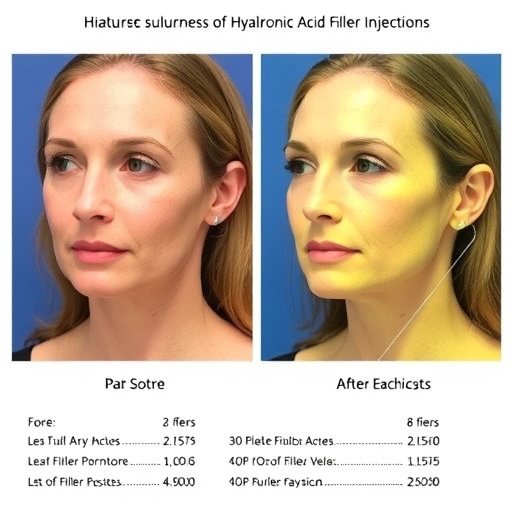In an unprecedented longitudinal study published in the October 2025 issue of Plastic and Reconstructive Surgery, researchers have leveraged cutting-edge three-dimensional digital scanning technology to elucidate the volumetric and patient-reported outcomes of hyaluronic acid (HA) facial fillers. This innovative investigation, led by Dr. Ivona Percec at the University of Pennsylvania, systematically quantified the immediate and extended effects of HA fillers on facial volume restoration. Combining detailed volumetric analyses with patient-reported data via the FACE-Q questionnaire, this research presents a highly nuanced perspective on the efficacy and durability of HA injections in facial rejuvenation.
Hyaluronic acid fillers have become the cornerstone of minimally invasive aesthetic treatments worldwide, with over 5.3 million procedures performed in 2024 alone, reflecting their unparalleled popularity for reversing the visual signs of aging. These fillers function primarily by replenishing volume lost due to dermal atrophy, thereby softening facial lines and wrinkles. Despite widespread use, gaps in the literature persist regarding the quantification of long-term volumetric changes and comprehensive patient satisfaction outcomes. Dr. Percec’s study addresses these critical gaps through a rigorously designed prospective evaluation incorporating 3D Vectra M3 imaging, aimed at capturing subtle volumetric nuances.
The cohort consisted of 101 women aged between 40 and 65 years, all recipients of multifaceted HA filler treatments designed to augment various facial compartments, including the midface, perioral regions, and lips. Methodologically, scans were acquired immediately prior to injection, immediately post-treatment, and subsequently at intervals ranging from two to twelve weeks. This strategic timing allowed researchers to isolate acute post-injection swelling from sustained volumetric changes attributable to the filler material itself.
A pivotal metric introduced in this analysis was the Tissue Displacement Factor (TDF), which quantified the percentage increase in tissue volume following filler administration. Initial results revealed a remarkable surge in facial volume immediately post-injection, with increases ranging between 56% and 125%, signaling the substantial immediate volumetric impact of HA fillers. However, as anticipated, this pronounced effect diminished as transient edema and inflammation resolved over subsequent days.
At the two-week mark, an evaluation of the Effective Volume (EV)—representing stable tissue augmentation after acute reactions subside—showed a retention of approximately 90% volume in the lower and midfacial areas, while the lips demonstrated a slightly lower retention rate near 70%. By twelve weeks, volume persistence averaged 66% across the entire face, with remarkable regional variability. The midface exhibited the highest maintenance at 79%, whereas the upper perioral zone, inclusive of marionette lines, retained 63%. The lips showed the least endurance, maintaining only 37%, a finding likely attributable to increased muscular activity and dynamic movement in these areas, as well as the specific physicochemical properties of the smaller particle HA formulations utilized.
Complementing these objective volumetric measurements, subjective patient outcomes derived from the FACE-Q questionnaire indicated robust enhancements in overall facial appearance and region-specific satisfaction. Importantly, patients reported significant improvements in psychosocial well-being, underscoring the broader impact of HA filler treatments beyond mere aesthetic correction. The correlation between volumetric data and patient satisfaction underscores the multidimensional benefits of these interventions.
The research further analyzed variables influencing volume retention, identifying factors such as patient age, smoking background, and body mass index as significant modulators of treatment outcomes. These findings emphasize the necessity for personalized treatment protocols that consider individual physiological and lifestyle parameters to optimize clinical efficacy.
Dr. Percec underscores the clinical implications of adopting volumetric metrics like TDF and EV in everyday practice, suggesting their utility in setting realistic expectations and refining HA filler selection. She advocates for routine integration of these measurements during patient consultations to enhance tailored treatment planning and maximize aesthetic results.
The differential volume maintenance observed between facial subregions shines a spotlight on the complex interplay between tissue dynamics and filler properties. Areas subjected to frequent animation, such as the lips, inherently experience greater volume attrition, revealing the challenges of achieving durable results in highly mobile facial zones. Meanwhile, the stability seen in the midface aligns well with its structural composition and relatively lower dynamic movement, fostering a more sustained filler presence.
This investigation also serves as a benchmark for future research aiming to refine HA filler formulations and delivery techniques. By correlating biomechanical outcomes with subjective patient experiences, it provides a comprehensive framework for evaluating novel aesthetic interventions with a balanced emphasis on efficacy and patient-centered care.
In conclusion, this monumental study not only advances the quantitative understanding of HA filler performance but also reinforces the therapeutic potential of these products in enhancing quality of life. The integration of objective volumetric analyses with validated patient-reported outcome measures paves the way for a new standard in aesthetic medicine, promising improved clinical protocols and enriched patient satisfaction over extended follow-up periods.
Subject of Research:
Quantitative assessment and patient-reported outcome analysis of volumetric changes following hyaluronic acid facial filler injections.
Article Title:
A Large Prospective Volumetric and Patient-Reported Outcome Analysis of Hyaluronic Acid Facial Fillers
News Publication Date:
26 September 2025
Web References:
https://journals.lww.com/plasreconsurg/fulltext/2025/10000/a_large_prospective_volumetric_and.15.aspx
Keywords:
Health and medicine, Clinical trials




